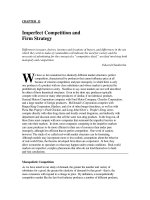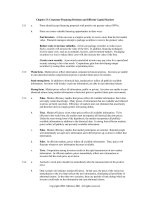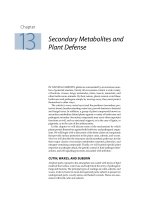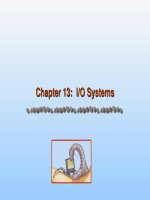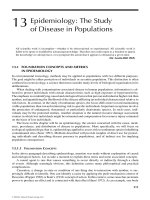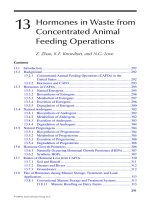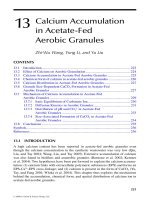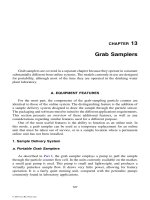Chapter 13 Io systems
Bạn đang xem bản rút gọn của tài liệu. Xem và tải ngay bản đầy đủ của tài liệu tại đây (904.62 KB, 38 trang )
Chapter 13: I/O Systems
Chapter 13: I/O Systems
13.2
Silberschatz, Galvin and Gagne ©2005
Operating System Concepts – 7
th
Edition, Jan 2, 2005
Chapter 13: I/O Systems
Chapter 13: I/O Systems
I/O Hardware
Application I/O Interface
Kernel I/O Subsystem
Transforming I/O Requests to Hardware Operations
Streams
Performance
13.3
Silberschatz, Galvin and Gagne ©2005
Operating System Concepts – 7
th
Edition, Jan 2, 2005
Objectives
Objectives
Explore the structure of an operating system’s I/O subsystem
Discuss the principles of I/O hardware and its complexity
Provide details of the performance aspects of I/O hardware and
software
13.4
Silberschatz, Galvin and Gagne ©2005
Operating System Concepts – 7
th
Edition, Jan 2, 2005
I/O Hardware
I/O Hardware
Incredible variety of I/O devices
Common concepts
Port
Bus (daisy chain or shared direct access)
Controller (host adapter)
I/O instructions control devices
Devices have addresses, used by
Direct I/O instructions
Memory-mapped I/O
13.5
Silberschatz, Galvin and Gagne ©2005
Operating System Concepts – 7
th
Edition, Jan 2, 2005
A Typical PC Bus Structure
A Typical PC Bus Structure
13.6
Silberschatz, Galvin and Gagne ©2005
Operating System Concepts – 7
th
Edition, Jan 2, 2005
Device I/O Port Locations on PCs (partial)
Device I/O Port Locations on PCs (partial)
13.7
Silberschatz, Galvin and Gagne ©2005
Operating System Concepts – 7
th
Edition, Jan 2, 2005
Polling
Polling
Determines state of device
command-ready
busy
Error
Busy-wait cycle to wait for I/O from device
13.8
Silberschatz, Galvin and Gagne ©2005
Operating System Concepts – 7
th
Edition, Jan 2, 2005
Interrupts
Interrupts
CPU Interrupt-request line triggered by I/O device
Interrupt handler receives interrupts
Maskable to ignore or delay some interrupts
Interrupt vector to dispatch interrupt to correct handler
Based on priority
Some nonmaskable
Interrupt mechanism also used for exceptions
13.9
Silberschatz, Galvin and Gagne ©2005
Operating System Concepts – 7
th
Edition, Jan 2, 2005
Interrupt-Driven I/O Cycle
Interrupt-Driven I/O Cycle
13.10
Silberschatz, Galvin and Gagne ©2005
Operating System Concepts – 7
th
Edition, Jan 2, 2005
Intel Pentium Processor Event-Vector Table
Intel Pentium Processor Event-Vector Table
13.11
Silberschatz, Galvin and Gagne ©2005
Operating System Concepts – 7
th
Edition, Jan 2, 2005
Direct Memory Access
Direct Memory Access
Used to avoid programmed I/O for large data movement
Requires DMA controller
Bypasses CPU to transfer data directly between I/O device and memory
13.12
Silberschatz, Galvin and Gagne ©2005
Operating System Concepts – 7
th
Edition, Jan 2, 2005
Six Step Process to Perform DMA Transfer
Six Step Process to Perform DMA Transfer
13.13
Silberschatz, Galvin and Gagne ©2005
Operating System Concepts – 7
th
Edition, Jan 2, 2005
Application I/O Interface
Application I/O Interface
I/O system calls encapsulate device behaviors in generic classes
Device-driver layer hides differences among I/O controllers from
kernel
Devices vary in many dimensions
Character-stream or block
Sequential or random-access
Sharable or dedicated
Speed of operation
read-write, read only, or write only
13.14
Silberschatz, Galvin and Gagne ©2005
Operating System Concepts – 7
th
Edition, Jan 2, 2005
A Kernel I/O Structure
A Kernel I/O Structure
13.15
Silberschatz, Galvin and Gagne ©2005
Operating System Concepts – 7
th
Edition, Jan 2, 2005
Characteristics of I/O Devices
Characteristics of I/O Devices
13.16
Silberschatz, Galvin and Gagne ©2005
Operating System Concepts – 7
th
Edition, Jan 2, 2005
Block and Character Devices
Block and Character Devices
Block devices include disk drives
Commands include read, write, seek
Raw I/O or file-system access
Memory-mapped file access possible
Character devices include keyboards, mice, serial ports
Commands include get, put
Libraries layered on top allow line editing
13.17
Silberschatz, Galvin and Gagne ©2005
Operating System Concepts – 7
th
Edition, Jan 2, 2005
Network Devices
Network Devices
Varying enough from block and character to have own interface
Unix and Windows NT/9x/2000 include socket interface
Separates network protocol from network operation
Includes select functionality
Approaches vary widely (pipes, FIFOs, streams, queues,
mailboxes)
13.18
Silberschatz, Galvin and Gagne ©2005
Operating System Concepts – 7
th
Edition, Jan 2, 2005
Clocks and Timers
Clocks and Timers
Provide current time, elapsed time, timer
Programmable interval timer used for timings, periodic interrupts
ioctl (on UNIX) covers odd aspects of I/O such as clocks and
timers
13.19
Silberschatz, Galvin and Gagne ©2005
Operating System Concepts – 7
th
Edition, Jan 2, 2005
Blocking and Nonblocking I/O
Blocking and Nonblocking I/O
Blocking - process suspended until I/O completed
Easy to use and understand
Insufficient for some needs
Nonblocking - I/O call returns as much as available
User interface, data copy (buffered I/O)
Implemented via multi-threading
Returns quickly with count of bytes read or written
Asynchronous - process runs while I/O executes
Difficult to use
I/O subsystem signals process when I/O completed
13.20
Silberschatz, Galvin and Gagne ©2005
Operating System Concepts – 7
th
Edition, Jan 2, 2005
Two I/O Methods
Two I/O Methods
Synchronous
Asynchronous
13.21
Silberschatz, Galvin and Gagne ©2005
Operating System Concepts – 7
th
Edition, Jan 2, 2005
Kernel I/O Subsystem
Kernel I/O Subsystem
Scheduling
Some I/O request ordering via per-device queue
Some OSs try fairness
Buffering - store data in memory while transferring between devices
To cope with device speed mismatch
To cope with device transfer size mismatch
To maintain “copy semantics”
13.22
Silberschatz, Galvin and Gagne ©2005
Operating System Concepts – 7
th
Edition, Jan 2, 2005
Device-status Table
Device-status Table
13.23
Silberschatz, Galvin and Gagne ©2005
Operating System Concepts – 7
th
Edition, Jan 2, 2005
Sun Enterprise 6000 Device-Transfer Rates
Sun Enterprise 6000 Device-Transfer Rates
13.24
Silberschatz, Galvin and Gagne ©2005
Operating System Concepts – 7
th
Edition, Jan 2, 2005
Kernel I/O Subsystem
Kernel I/O Subsystem
Caching - fast memory holding copy of data
Always just a copy
Key to performance
Spooling - hold output for a device
If device can serve only one request at a time
i.e., Printing
Device reservation - provides exclusive access to a device
System calls for allocation and deallocation
Watch out for deadlock
13.25
Silberschatz, Galvin and Gagne ©2005
Operating System Concepts – 7
th
Edition, Jan 2, 2005
Error Handling
Error Handling
OS can recover from disk read, device unavailable, transient write
failures
Most return an error number or code when I/O request fails
System error logs hold problem reports
